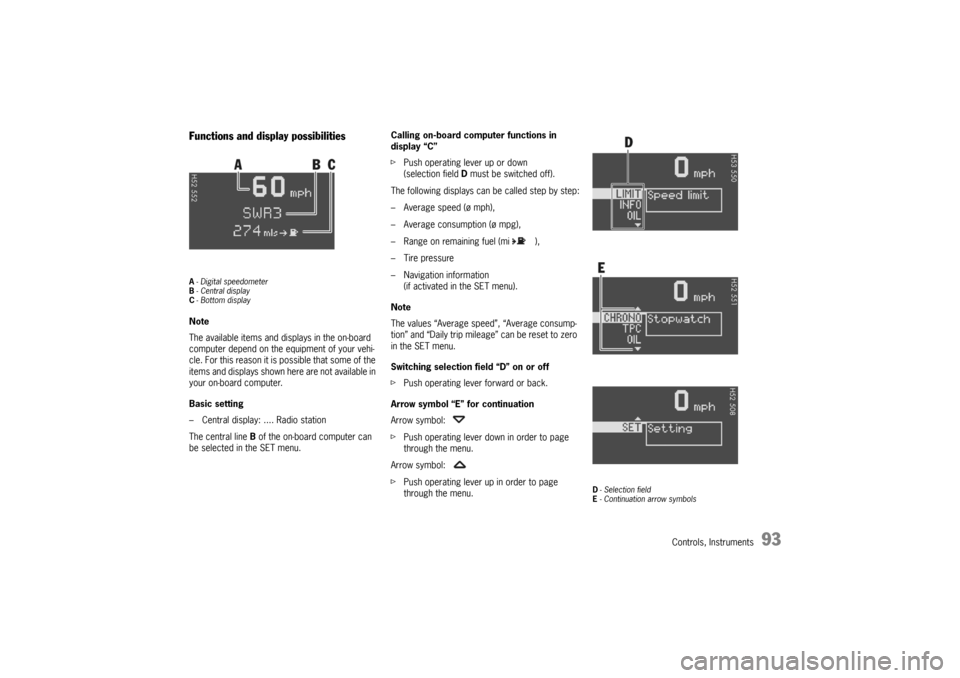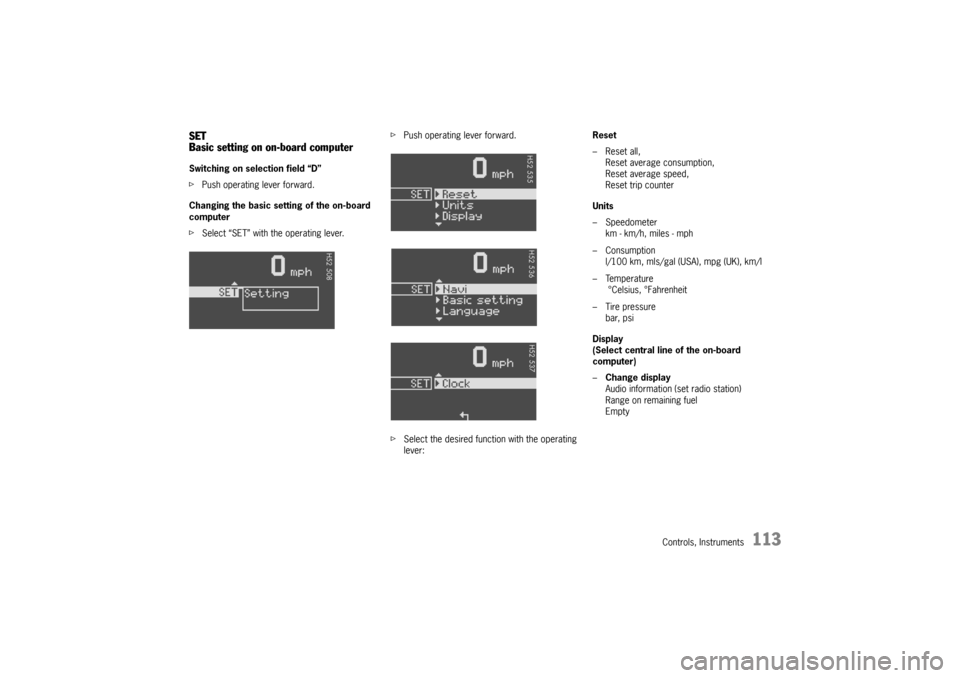2006 PORSCHE BOXSTER fuel consumption
[x] Cancel search: fuel consumptionPage 14 of 296

14
Controls, Instruments
Break in hints for the first
2,000 miles/3,000 kilometers The following tips will be helpful in obtaining opti-
mum performance from your new Porsche.
Despite the most modern, high-precision manufac-
turing methods, it cannot be completely avoided
that the moving parts have to wear in with each
other. This wearing-in occurs mainly in the first
2,000 miles/3,000 km. Therefore: fPreferably take longer trips.
fAvoid frequent cold starts with short-distance
driving whenever possible.
fAvoid full throttle starts and abrupt stops.
fDo not exceed maximum engine speed of
4,200 rpm (revolutions per minute).
fDo not run a cold engine at high rpm either in
Neutral or in gear.
fDo not let the engine labor, especially when dri-
ving uphill. Shift to the next lower gear in time
(use the most favorable rpm range).
fNever lug the engine in high gear at low
speeds. This rule applies at all times, not just
during the break-in period. fDo not participate in motor racing events,
sports driving schools, etc. during the first
2,000 miles/3,000 kilometers.
There may be a slight stiffness in the steering,
gear-shifting or other controls during the break-in
period which will gradually disappear.
Break in brake pads and break discsNew brake pads and discs have to be “broken in”,
and therefore only attain optimal friction when the
car has covered several hundred miles or km.
The slightly reduced braking ability must be com-
pensated for by pressing the brake pedal harder.
This also applies whenever the brake pads and
brake discs are replaced. New tires New tires do not have maximum traction. They
tend to be slippery.
fBreak in new tires by driving at moderate
speeds during the first 60 to 120 miles/100 to
200 km. Longer braking distances must be an-
ticipated.
Engine oil and fuel consumption During the break-in period oil and fuel consumpti-
on may be higher than normal.
As always, the rate of oil consumption depends on
the quality and viscosity of oil, the speed at which
the engine is operated, the climate and road con-
ditions, as well as the amount of dilution and oxi-
dation of the lubricant.
fMake a habit of checking engine oil with every
fuel filling, add if necessary.
Page 93 of 296

Controls, Instruments
93
Functions and display possibilitiesA- Digital speedometer
B-Central display
C- Bottom displayNote
The available items and displays in the on-board
computer depend on the equipment of your vehi-
cle. For this reason it is possible that some of the
items and displays shown here are not available in
your on-board computer.
Basic setting
– Central display: .... Radio station
The central line B of the on-board computer can
be selected in the SET menu.Calling on-board computer functions in
display “C”
fPush operating lever up or down
(selection field D must be switched off).
The following displays can be called step by step:
– Average speed (ø mph),
– Average consumption (ø mpg),
– Range on remaining fuel (mi ),
– Tire pressure
– Navigation information
(if activated in the SET menu).
Note
The values “Average speed”, “Average consump-
tion” and “Daily trip mileage” can be reset to zero
in the SET menu.
Switching selection field “D” on or off
fPush operating lever forward or back.
Arrow symbol “E” for continuation
Arrow symbol:
fPush operating lever down in order to page
through the menu.
Arrow symbol:
fPush operating lever up in order to page
through the menu.
D- Selection field
E- Continuation arrow symbols
Page 113 of 296

Controls, Instruments
113
SET
Basic setting on on-board computerSwitching on selection field “D”
fPush operating lever forward.
Changing the basic setting of the on-board
computer
fSelect “SET” with the operating lever.fPush operating lever forward.
fSelect the desired function with the operating
lever:Reset
– Reset all,
Reset average consumption,
Reset average speed,
Reset trip counter
Units
– Speedometer
km - km/h, miles - mph
–Consumption
l/100 km, mls/gal (USA), mpg (UK), km/l
– Temperature
°Celsius, °Fahrenheit
– Tire pressure
bar, psi
Display
(Select central line of the on-board
computer)
–Change display
Audio information (set radio station)
Range on remaining fuel
Empty
Page 114 of 296

114
Controls, Instruments Navigation
– Integrated in the BC
(Navigation instructions can be recalled on the
on-board computer display)
– When turning off
(Navigation instructions are only shown before
changing direction)
Basic setting
– Restore the basic setting of the on-board com-
puter
Language
– Select language version
12/24h mode
– Select time mode:
12h (small squares on the right side of the time
display for AM/PM),
24h
General information regarding the
on-board computer functionsRange on remaining fuel
The range on remaining fuel is continuously recal-
culated during the journey based on the fuel level,
current consumption and average consumption.
The more the fuel level falls, the more spontan-
eously the display reacts. For this reason, the
range on remaining fuel is not displayed if less
than 9 miles (15 kilometers).
If the vehicle's inclination changes while driving or
refuelling, incorrect range information may tempo-
rarily be given.
Note
If the tank is nearly empty and you top up with only
a small quantity of fuel, an accurate range on re-
maining fuel is impossible.Average consumption and average speed
The values displayed are based on the distance
travelled since the last reset to “zero”.
You can set the starting time for a measurement
before or during the trip.
Switching the ignition off does not reset the meas-
urements. It is therefore possible to collect values
over long periods.
Disconnecting the car battery will cause these
memories to be erased.
Tire pressure
The Tire pressure function of the on-board com-
puter displays the tire pressures dependent on
temperature in the four wheels. You can watch the
tire pressure rise and fall while driving.
The display is only for information. To correct the
tire pressures, always use the displayed values
from the “Info pressure” display in the Tire pres-
sure menu.
Page 188 of 296

188
Maintenance, Car Care
Engine Oil Engine oil consumption
It is normal for your engine to consume oil.
The rate of oil consumption depends on the quality
and viscosity of oil, the speed at which the engine
is operated, the climate, road conditions as well
as the amount of dilution and oxidation of the lub-
ricant.
If the vehicle is used for repeated short trips, and
consumes a normal amount of oil, the engine oil
measurement may not show any drop in the oil le-
vel at all, even after 600 miles (1000 km) or more.
This is because the oil is gradually becoming dilut-
ed with fuel or moisture, making it appear that the
oil level has not changed.
The diluting ingredients evaporate out when the
vehicle is driven at high speeds, as on an express-
way, making it then appear that oil is excessively
consumed after driving at high speeds.
If the conditions you drive your vehicle in are dus-
ty, humid, or hot, the frequency of the oil change
intervals should be greater. If the vehicle is driven at a high rate of speed, cli-
matic conditions are warm, and the load is high,
the oil should be checked more frequently, as dri-
ving conditions will determine the rate of oil con-
sumption.
– The engine in your vehicle depends on oil to lu-
bricate and cool all of its moving parts.
Therefore, the engine oil should be checked re-
gularly and kept at the required level.
– Make it a habit to have the engine oil level che-
cked with every fuel filling.
– The oil pressure warning light is not an oil level
indicator.
The oil pressure warning light indicates serious
engine damage may be occuring when lit, if en-
gine rpm is above idle speed.
Page 194 of 296

194
Maintenance, Car Care
Fuel Economy Fuel economy will vary depending on where,
when and how you drive, optional equipment
installed, and the general condition of your
car.
A car tuned to specifications and correctly
maintained, will help you to achieve optimal
fuel economy.
fHave your vehicle tuned to specifications.
Air cleaner should be dirt free to allow proper
engine “breathing”.
Battery should be fully charged.
Wheels should be properly aligned.
Tires should be inflated at correct pressure.
fAlways monitor your fuel consumption.
fDrive smoothly, avoid abrupt changes in speed
as much as possible.
fAvoid jack rabbit starts and sudden stops.
fDo not drive longer than necessary in the lower
gears. Shifting into a higher gear early without
lugging the engine will help save fuel.
fProlonged “warm up” idling wastes gas. Start
the vehicle just before you are ready to drive.
Accelerate slowly and smoothly.
fSwitch off the engine if stationary for longer
periods (traffic lights, jams, level crossings). fAny additional weight carried in the vehicle re-
duces fuel economy. Always keep cargo to a
minimum and remove all unnecessary items.
fOrganize your trips to take in several errands
in one trip.
fAll electrical accessories contribute to increa-
sed fuel consumption.
fOnly switch on the air conditioning when neces-
sary.
The EPA estimated m.p.g. is to be used for
comparison purposes, actual mileage may
be different from the estimated m.p.g., de-
pending on your driving speed, weather con-
ditions and trip length. Your actual highway
mileage will probably be less than the esti-
mated m.p.g.
fPlease observe all local and national speed li-
mits.
Page 293 of 296

Index
293
Warning light ........................................ 86
Cooling system .....................................86
, 186
Cruise control ............................................... 82
Cupholder .................................................. 144
DDashboard ................................................... 72
Data bank .................................................. 278
Defrosting windows .............................130
, 133
Diagnostic socket .................................15, 247
Diagrams ................................................... 288
Dimensions ................................................ 287
Dipped beam .............................................. 261
Door ............................................................ 25
Guard lights ........................................ 271
Handles................................................ 25
Locks...........................................25, 212
Mirror heating ....................................... 33
Windows ....................... 25
, 28, 170
, 214
Driving hints ................................................. 12
Driving in winter .......................................... 168
Driving performance ................................... 285
Drop-center rim .......................................... 234
DVD Navigation........................................... 152
EElectrical system ........................................ 246
Emergency flasher ...................................... 137
Emergency operation
Central locking................................19
, 22
Convertible top ................................... 173
Lids ................................................... 248
Tank cap ............................................ 197Emergency program, Tiptronic .....................168
Emergency service......................................220
Emergency starting with jump leads .............256
Emergenzy operation....................................22
Emission control system ........... 7
, 90, 200
, 201
Engine
Checking the oil level ...........................111
Exhaust ..................................................8
Number ..............................................279
Oil consumption ....................................14
Oil level indicator.................................111
Oils ....................................................286
Speeds ................................................14
Starting ................................................74
Switching off.........................................74
Engine compartment
Blower .......................................... 77, 86
Lid ............................................ 151, 203
Lid warning light ..................................150
Environment ...................................................6
FFire extinguisher .........................................147
Flat tire ......................................................238
Floor mats ..................................................217
Fog lights .................................. 124
, 266
, 269
Footwell light ..............................................270
Front lid......................................................151
Fuel ................................................ 4
, 88, 196
Containers ..............................................8
Economy ............................................194
Evaporation ........................................202
Level gauge ..........................................88
Level warning light................................88Portable Containers ............................ 199
Recommendation ....................... 198
, 199
Tank.......................................... 196, 197
Function keys ............................................... 40
Fuses ........................................................ 247
GGarage door opener................................... 158
Garage lift ................................................. 237
Gearchanging ............................................ 161
Glove compartment .................................... 143
Gong .............................. 75
, 76, 94, 123
, 124
Ground clearance ........................................... 8
HHandbrake ................................................... 57
Hardtop ..................................................... 178
Headlights ......................................... 125
, 261
Adjusting ................................... 272, 273
Cleaning system ................. 126
, 202
, 286
Heated rear window...................... 33
, 181
, 182
Heating ............................................. 130, 133
High beam
Indicator light ....................................... 85
Lever......................................... 124, 125
Home mode............................................... 124
HomeLink .................................................. 158
Hoods ............................................... 148, 151
Horn ..................................................... 15, 21